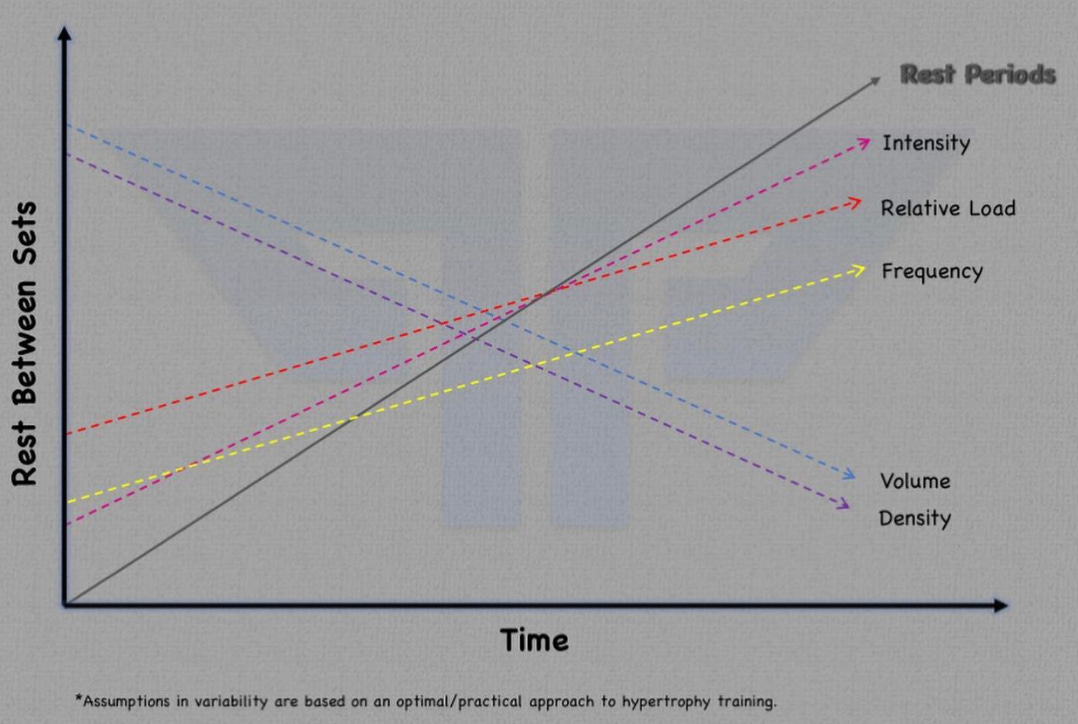A measure of the time taken to recover between sets.
Last but not least — linear changes in REST PERIODS (between working sets)
- All set volume is performed on a single bodypart/lift versus divided up systemically (i.e. all sets inferred to be from leg extension/biceps curls/etc)
- Volume- 15 sets per week
- Density- 1:1 ratio with volume
- Frequency- 2x/wk
- Intensity- 3RIR
- Relative Load- 70% of 1RM
The effects discussed — and graphed — are going to be a function of an isolated comparison between our independent variable (here, rest periods) and a dependent variable (we will evaluate them one at a time). The above parameters will act as standardization values when those variables are not being compared directly to volume.
Volume
Because we are only discussing the number of sets here and not volume load (i.e. weight x sets x reps), performance is not going to be part of the criteria by which we are evaluating this relationship (though this is obviously disconnected from practical application). As rest periods go from the low end of what is acceptable (~30 sec) to the upper end (~8-10 min), volume will be trending down because of the time constraints. What makes this somewhat confusing is trying to separate the fictitious scenario presented from what will actually occur in reality if we were to allow all variables to naturally adjust in unison.
Density
Now that we have added a time component, we can see that density must decrease inversely with increasing rest periods.
Frequency
Longer rest will generally mean more time for recovery, with all else being equal. So as we increase that rest period before our next set, we will able to spread volume out a bit more over the week. Again, this gets much more tricky in practice.
Intensity
Here is where we start seeing more tangible effects of manipulating rest periods. Advanced trainees will understand just how much mental fortitude plays into intensity. The right psychology is a prerequisite, but you must also allow for that mental battery to recharge between sets. Then there are the physiological demands of high intensity — increased respiration rate, elevated local metabolite accumulation, and depletion of glycogen/creatine/ATP stores — all of which need to be return to baseline before the next set. Increasing rest periods will directly allow for more intensity to be generated on a per set basis.
Relative Load
Comparisons of RP vis-a-vis RL will fall much more in the realm of what is practical and logical, versus what is theoretically possible. Even though we can technically work in all ranges of relative loads no matter how long we rest, weighing the risk-reward makes it clear: attempting to maintain any level of sufficient intensity with high loads and short rest is just not very smart. It is, therefor, good practice to allow for RL to titrate up with increased rest periods due to improved recovery and less risk of injury.
Though this variable seems relatively straight forward, it’s important to understand the principle of diminishing returns as this will become a theme quickly.
For best hypertrophic results, it is generally accepted that we should take long enough rest to perform optimally, but not so long that we’re sacrificing intrasession volume or neurological output.
This almost always correlates to a rest interval of 1-5 minutes between sets. The lower end of this is reserved for less-risky work where density and metabolic stress is the goal (i.e. a superset of biceps curls and triceps pushdowns), whereas the upper limit and beyond can be a great place for the sets that are driving overload/progression that might carry a bit more risk (i.e. sets of 4-6 on deadlifts taken close to failure).
Rest periods can often be neglected and relegated to an afterthought in the pursuit of more volume/density/caloric burn, but this line of thinking leave a ton on the table in terms of growth and strength potential. Outside of specific instances where rest periods are modulated for a desired effect (metabolite or higher density work), allow yourself to catch your breath. Let your heart rate return to normal. Clear your head and prepare yourself for the impending misery of a set taken close to failure with a full physiological/mental gas tank!

